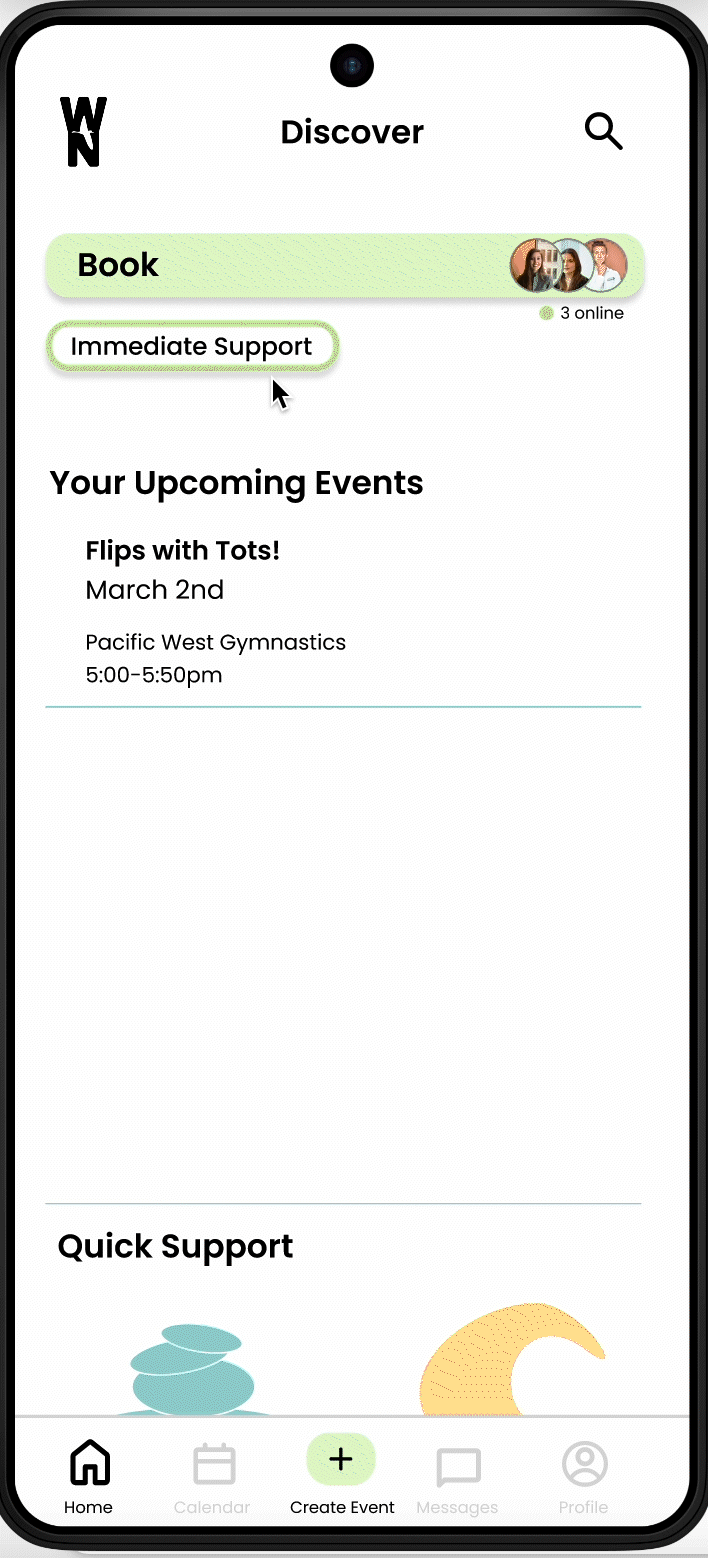WellNest
Providing postpartum mothers with community and mental health professionals.
Role
High-fidelity Lead, UI/UX Designer
Timeline
February 22-23 (24 hour design-a-thon)
Team
Developer & UX Researcher (1)
UI/UX Designers (2)

Overview
Project Brief
Several mental health apps exist on the market for children and teens. However, none focused on parents, specifically postpartum women.
Challenge Prompt
"Design a digital experiences that demonstrates the transformative power of design by creating moments of insight, connection, or growth. Select an industry, identify what impact you want to make as a designer. Aim to create lasting emotional impact, be bold and purposeful. The solution should guide user through a transformative experience/journey"
Problem Statement
Several mental health apps exist on the market for children and teens. However, none focused on parents, specifically postpartum women. How might we help new moms connect with mental health professionals and other moms following their childbirth?
Awarded Best Beginner Design for Design Interactive Design Fest, judged by a panel of industry experts from Microsoft, Lowe's, and ServiceNow
User Research
Interviews
We asked parents of young children (n=6) how they learned to take care of a child and work postpartum.
First Focus: maintaining relationships and connections
90% reported struggles with keeping connections after birth
45% mentioned needing another person to help
Second Focus: resources for parenting
50% reported learning how to parent through other mothers
40% reported learning using parenting books, but noted the inconvenience of the form
Conclusion
Top problems postpartum mother's face is connecting with her community and balancing mental health while being a working mother
Scholarly Research
1 in 10 women will be diagnosed with PPD (postpartum depression) following childbirth
~30% of women diagnosed will reach out for professional help due to (but not limited to) financial, time, and transportation constraints
Postpartum Depression Rates are Higher in Minority Communities
Prevalence of postpartum depression increased from 2010-2021
-
Whites: from 13.5% to 21.8% (a 60% increase)
-
Hispanic: from 8.9% to 18.8% (a 110% increase)
-
Black: from 9.2% to 22% (a 140% increase)
-
API: largest relative increase from 3.6% to 13.8% (a 280% increase)
Synthesis
User Persona
Maria recently had a baby girl a couple of days ago and she’s felt tired 24/7 in between the baby waking her up at random hours and having to do it all on her own. Her spouse has their own job, so frequently is too busy to help her out. She feels like she is drowning in the amount of work required to take care of her baby and she worries that she is not doing anything right. She asks advice from friends and family, but she feels like nobody really relates to her experience.
Pain Points
-
Finding time to maintain connections
-
Feeling confident in parenting
-
Higher rates of postpartum depression in minority groups
-
Finding flexible opportunities to see healthcare professionals
-
Trouble reaching out for help and finding community
Competitor Analysis
Parenting Apps on the Market

Ideation
Brainstorming Key Features

Low-Fidelity
Sketching Key Features
Using insights from field research, user persona, mapping, and feature ideation, I sketched possible solutions to address our user pain-points and problem statement. My main focus was designing the features that would connect women to community, including the immediate support, booking, and messaging tools.

Mid-Fidelity
Wireframes

Creating an Event


Booking with Healthcare Professional
User Flows for Key Tasks

Book with Healthcare Professional


Immediate Chat Support

Create an Event

Usability Testing
Organization of Key Pain Points
We selected 3 key user flows, keeping the project time constraint in mind, to prompt users to test.
Final Solution
Design System Conforms to WCAG Accessibility Standards

Final Features

Immediate Support Chat
Reflection & Next Steps


This project deepened my understanding of UX design, accessibility, and mental health support, particularly for postpartum mothers. Researching challenges like postpartum depression, isolation, and access to resources reinforced the importance of user-centered design in real-world solutions.
A key lesson was translating research insights into functional design choices. Prioritizing simplicity helped reduce cognitive load, while following WCAG accessibility guidelines ensured inclusivity. Prototyping for Android first highlighted the need for financial accessibility, making mental health support more portable and widely available.
Additionally, I strengthened my ability to integrate professional services and community support into a seamless experience while collaborating across disciplines to achieve cohesive design solutions.
Key Takeaways:
-
User-Centered Focus – Research-driven decisions over personal preferences.
-
Feature Prioritization – Streamlining key functionalities for ease of use.
-
Accessibility Compliance – Ensuring inclusive, WCAG-compliant design.
-
Cross-Disciplinary Collaboration – Effective teamwork for cohesive solutions.
-
This experience reinforced my passion for empathetic, research-driven design, and I look forward to applying these principles to take this project further.

Create an Event

Message Network
